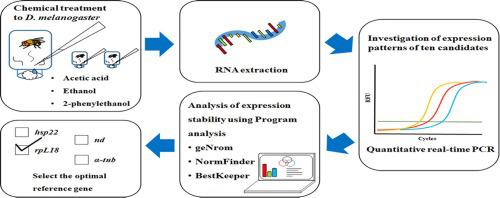Journal of Asia-Pacific Entomology ( IF 1.1 ) Pub Date : 2020-01-23 , DOI: 10.1016/j.aspen.2020.01.008 YeongHo Kim , YiSeul Kim , Young Ho Kim

|
The fruit fly, Drosophila melanogaster, is mainly found in fermented and rotten fruits and is more tolerant to chemicals emitted during the fermentation process than other organisms. Its distinctive habitat suggests an evolutionary adaptation to the chemicals, such as acetic acid, ethanol, and 2-phenylethanol. Quantitative real-time PCR (qRT-PCR) assays can be performed to analyze the expression patterns of D. melanogaster genes putatively involved in chemical detoxification and metabolism, to better understand D. melanogaster adaptions to its environment. The selection of stably-expressed, internal reference genes across samples is crucial for accurate normalization of target gene expression parameters. In this study, we investigated the transcription levels of ten candidate reference genes: hsp22, ef1β, α-tub, rpL18, rpS3, argk, nd, tbp, gapdh, and ace, in D. melanogaster exposed to various concentrations of acetic acid, ethanol, and 2-phenylethanol, and expression stability of these genes was evaluated using three different programs: geNorm, NormFinder, and BestKeeper. These three software resulted in different stable genes, but suggested the selection of multiple reference genes for target gene normalization. For validation of reference genes, expression levels of adh were normalized with different references and combination of multiple genes. In the flies exposed to three chemicals, rpL18 was commonly suggested to be used for the most stable reference gene for comparing expression levels of genes potentially associated with environmental chemical tolerance in D. melanogaster.
中文翻译:

暴露后使用定量实时PCR评估果蝇中参考基因的基因表达研究
果蝇果蝇(Drosophila melanogaster)主要存在于发酵和腐烂的水果中,并且比其他生物体更能耐受发酵过程中排放的化学物质。它独特的栖息地表明对乙酸,乙醇和2-苯基乙醇等化学物质的进化适应。可以进行定量实时PCR(qRT-PCR)分析来分析推测参与化学排毒和代谢的D. melanogaster基因的表达模式,以更好地了解D. melanogaster适应其环境。跨样品选择稳定表达的内部参考基因对于准确标准化靶基因表达参数至关重要。在这项研究中,我们研究了十种候选参考基因在暴露于各种乙酸浓度的黑腹果蝇中的hsp22,ef1β,α-tub,rpL18,rpS3,argk,nd,tbp,gapdh和ace的转录水平。乙醇和2-苯基乙醇,并使用geNorm,NormFinder和BestKeeper这三个程序评估了这些基因的表达稳定性。这三个软件产生了不同的稳定基因,但建议选择多个参考基因以进行靶基因标准化。为了验证参考基因,表达水平adh用不同的参考文献和多个基因的组合进行标准化。在暴露于三种化学物质的果蝇中,通常建议将rpL18用作最稳定的参考基因,以比较黑腹果蝇中与环境化学耐受性相关的基因的表达水平。











































 京公网安备 11010802027423号
京公网安备 11010802027423号